| کد مقاله | کد نشریه | سال انتشار | مقاله انگلیسی | نسخه تمام متن |
|---|---|---|---|---|
| 4080912 | 1267571 | 2015 | 5 صفحه PDF | دانلود رایگان |

IntroductionFor the surgeon and patient, permanent removal of an infected knee prosthesis is an unwelcome decision taken out of necessity because unfavourable local or general conditions may increase the likelihood of mechanical or infectious failure upon prosthesis reimplantation. The purpose of this study was to determine if permanent removal of an infected total knee arthroplasty (TKA) implant controls the infection and prevents above-the-knee amputation when reimplantation turns out to be too risky. It was hypothesized that removal without reimplantation contributes to eradicating the infection and helps to avoid amputation.Patients and methodsSeventy-two consecutive patients who underwent TKA removal between 2000 and 2010 at 14 hospitals were reviewed. The TKA removal was followed by knee fusion in 29 cases or implantation of a permanent cement spacer in 43 cases.ResultsIf failure is defined as clinically obvious recurrence of the infection, the survival rate was 65 ± 5% at 2 years; 44% of patients had a recurrence of the infection, 8% had undergone amputation and 19% presented with nonunion at the last follow-up. The male gender and the presence of multiple co-morbidities were predisposing factors for failure.DiscussionControl of the infection is not guaranteed upon TKA implant removal; the success rate is lower than in cases of two-stage reimplantation. The outcomes in this study are worse than those of other published studies. This is likely due to the heterogeneity in the patient population and treatments, along with the presence of co-morbidities. This treatment option should be the last recourse before amputation.Level of evidenceLevel IV, Retrospective cohort study.
Journal: Orthopaedics & Traumatology: Surgery & Research - Volume 101, Issue 6, Supplement, October 2015, Pages S251–S255